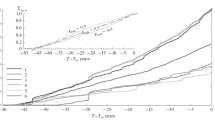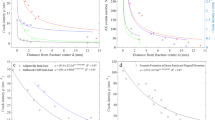Abstract
The present paper gives a scale of earthquake energy class KF that is to standardize the relevant data based on the existing scales: MS, MW, mb, KS, among many others. The conceptual novelty of the scale we propose consists in shifting the emphasis from seismometric issues that are traditional in such cases, which are concerned with the recording of seismic waves, as well as with issues arising in discussions of their generation and propagation, toward an effective use of basic energy properties of the seismic process (the Gutenberg–Richter law). In the most general case, this approach can significantly simplify the development of regression relations between different earthquake size scales, but the most promising problem consists in developing a single generalized scale. A particular solution of the problem is presented as the development of such a scale for earthquakes of Kamchatka. The KF scale rests on the energy class \(K_{{S1.2}}^{{F68}}\) proposed by S.A. Fedotov (KS at the Kamchatka Branch (KB) of the National Seismological Centre, Geophysical Survey, Russian Academy of Sciences (NSC GS RAS) and on the generally accepted mb magnitude (ISC).







Similar content being viewed by others
Notes
https://earthquake.usgs.gov/earthquakes/search/.
http://sdis.emsd.ru/info/earthquakes/catalogue.php.
http://www.isc.ac.uk.
The saw-toothed appearance in the right part of the plot can be considerably diminished by linear smoothing applied, not to the variational series of energy classes K, but to the corresponding variational series of 1/S. This variant has greater promise, but there is no essential difference between the two kinds of smoothing in the framework of the present study.
https://www.usgs.gov/natural-hazards/earthquake-hazards/science/earthquake-magnitude-energy-release-and-shaking-intensity?qt-science_center_objects=0#qt-science_center_objects.
REFERENCES
Aki, K., Maximum likelihood estimate of b in the formula lg N = a – bM and its confidence limits, Bull. Earth. Res. Inst., 1965, vol. 43, pp. 237‒239.
Benioff, H., Earthquakes and rock creep, Bull. Seismol. Soc. Amer., 1951, vol. 41, pp. 50‒62.
Choy, G.L. and Boatwright, J.L., Global patterns of radiated seismic energy and apparent stress, J. Geophys. Res., 1995, vol. 100, pp. 18 205‒18 228.
Di Giacomo, D., Grosser, H., Parolai, S., et al., Rapid determination of ME for strong to great shallow earthquakes, Geophys. Res. Letters., 2008, vol. 35. L1030. https://doi.org/10.1029/2008GL033505
Fedotov, S.A. Energeticheskaya klassifikatsiya Kurilo-Kamchatskikh zemletryasenii i problema magnitud (The Energy Classification of Earthquakes and the Magnitude Problem), Moscow: Nauka, 1972.
Fedotov, S.A., Dolgosrochnyi seismicheskii prognoz dlya Kurilo-Kamchatskoi dugi (Long-term Earthquake Prediction for the Kuril–Kamchatka Arc), Moscow: Nauka, 2005.
Gusev, A.A. and Melnikova, V.N., Relationships between magnitudes for global and Kamchatkan earthquakes, Vulkanol. Seismol., 1990, no. 6, pp. 55–63.
Gutenberg, B. and Richter, C.F., Seismicity of the Earth and Associated Phenomena, Princeton: Princeton University Press, 1949.
Kanamori, H., The energy release in great earthquakes, J. Geophys. Res., 1977, vol. 82, pp. 2981‒2987.
Kukinov, A.M., Using order statistics and rank tests in data processing, in Poisk zavisimosti i otsenka pogreshnosti (Looking for Relationship and Estimating the Uncertainty), Pinsker, I.Sh., Editor-in-Chief, Moscow: Nauka, 1985, pp. 97–110.
Lemzikov, V.K. and Gusev, A.A., The energy classification of near Kamchatka earthquakes based on coda level, Vulkanol. Seismol., 1989, no. 4, pp. 83–97.
Riznichenko, Yu.V., A method for summing earthquakes to study seismic activity, Izv. AN SSSR, Ser. Geofiz., 1964, no. 7, pp. 969‒977.
Sadovsky, M.A., Geofizika i fizika vzryva (Geophysics and Explosion Physics), Selected works, Moscow: Nauka, 2004.
Solomatin, A.V., The law of earthquake recurrence and the energy balance of the seismic process, Voprosy Inzhenern. Seismol., 2011, vol. 38, no. 4, pp. 39‒48.
Solomatin, A.V., The energy spectrum of the seismic process in application to long-term earthquake prediction and intermediate- and short-term updating of earthquake hazard, J. Volcanol. Seismol., 2021, vol. 15, no. 2, pp. 133–144.
Author information
Authors and Affiliations
Corresponding author
Additional information
Translated by A. Petrosyan
Rights and permissions
About this article
Cite this article
Solomatin, A.V. The Energy Properties of the Seismic Process and the Feasibility of Introducing a Generalized Energy Class of Earthquakes. J. Volcanolog. Seismol. 16, 311–321 (2022). https://doi.org/10.1134/S0742046322040078
Received:
Revised:
Accepted:
Published:
Issue Date:
DOI: https://doi.org/10.1134/S0742046322040078




